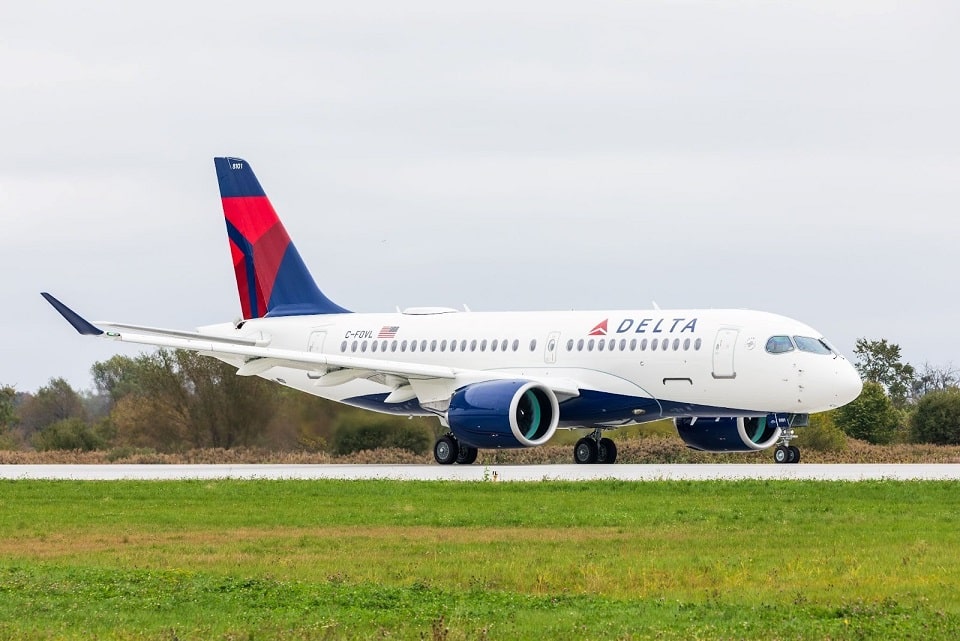Airlines
Delta Air Lines firms order for 12 additional A220 aircraft

Delta Air Lines has firmed up an order for a dozen more A220-300 aircraft, bringing the airline’s total firm order for A220s to 119 aircraft – 45 A220-100s and 74 A220-300s. Throughout the years, Delta has reordered the A220 four times and is today the largest A220 customer and operator.
Top 5 selling Narrow Body aircraft(Opens in a new browser tab)
Delta took delivery of its first Airbus A220 in October 2018, and was the first U.S. carrier to operate the aircraft type. Delta currently owns a fleet of 415 Airbus aircraft, including 59 A220 aircraft, 266 A320 Family aircraft, 62 A330s and 28 A350-900 aircraft.
The A220 is the only aircraft purpose-built for the 100-150 seat market, bringing together state-of-the-art aerodynamics, advanced materials and Pratt & Whitney’s latest-generation GTF™ engines. The A220 brings customers a 50 percent reduced noise footprint as well as around 50 percent lower NOx emissions than industry standards.
With 246 A220s delivered to 16 airlines operating on four continents, the A220 is the optimal aircraft to offer operational flexibility for both regional as well as long-distance routes. To date, more than 70 million passengers have enjoyed the A220. The fleet is currently flying on over 825 routes and 325 destinations worldwide. As of the end of December 2022, nearly 30 customers have ordered close to 800 A220 aircraft – confirming its leading position in the small single-aisle market.

Airlines
Air India Rolls Out A350s for Delhi-New York JFK and Newark Routes

In a major development for North American travelers, Air India has announced the deployment of its state-of-the-art Airbus A350-900 aircraft on two key routes: Delhi to New York and Delhi to Newark.
The service on the Delhi-New York route will commence on November 1, 2024, while the Delhi-Newark route will see its inaugural flight on January 2, 2025.
The introduction of the air india a350 will bring significant enhancements to Air India’s offerings, particularly with the launch of its Premium Economy class. air india retrofit This new class will feature 24 wide seats arranged in a 2-4-2 configuration, providing passengers with extra legroom and a more comfortable flying experience.
Soon, Air India aircraft will feature onboard WiFi & all-new cabins: Click here
“We are encouraged by the positive guest feedback we have received from the domestic deployment of our air india a350 interior to offer our hero product on the Delhi-New York JFK and Delhi-Newark routes. This is a significant leap forward for our U.S. operations that also underscores our commitment to continuous improvement,” said Campbell Wilson, Chief Executive Officer & Managing Director of Air India.
The A350’s Business class will set new standards with 28 private suites, each equipped with full-flat beds, direct aisle access, and personal wardrobes. Economy class will be configured to accommodate 264 passengers in a 3-4-3 layout. Across all cabins, passengers will enjoy the latest Panasonic eX3 in-flight entertainment system, offering over 2,200 hours of content.
Air India’s First A350-900: Interior, Routes, &Inflight Features: Click here
This strategic deployment marks a notable enhancement in Air India’s U.S. operations, with 60% of its flights to the U.S. now featuring new or upgraded cabin interiors. The air india new international routes currently operates 51 weekly flights to five U.S. destinations: New York JFK, Newark, Washington DC, Chicago, and San Francisco.
The revamped cabins, advanced in-flight entertainment systems, and improved service standards represent air india wifi commitment to providing a superior travel experience. “We believe this enhanced offering will solidify Air India’s position as a leading carrier and attract travellers seeking a world-class flying experience between India and the United States,” the airline stated.
Seats on these flights are now available for booking on Air India’s website, mobile app, and through travel agents, ensuring that passengers can easily plan their journeys on these newly upgraded routes.
Air India Economy vs Qatar airways economy: which is best?:Click here
-

 Travel1 week ago
Travel1 week agoAir India to Expand US Operations with Three New Routes After a Decade
-

 Travel2 weeks ago
Travel2 weeks agoWhy We Should Avoid These Stamps in a Passport
-

 Airlines1 month ago
Airlines1 month agoInvestigations Reveal Fake Chinese Titanium in Boeing and Airbus Jets
-

 Tech4 weeks ago
Tech4 weeks agoChina’s CATL Plans 1,800-Mile Electric Plane Launch by 2027
-

 Airport3 days ago
Airport3 days agoTop 10 Largest Airports in the World by Size
-

 Aerospace4 weeks ago
Aerospace4 weeks agoChina’s Fighter Jets Turn Wings into Autonomous Drones
-

 Airlines4 days ago
Airlines4 days agoAir India Rolls Out A350s for Delhi-New York JFK and Newark Routes
-

 Defence3 weeks ago
Defence3 weeks agoBoeing Enhances Chinook with New Engines and Block II Upgrades at $96 Million







